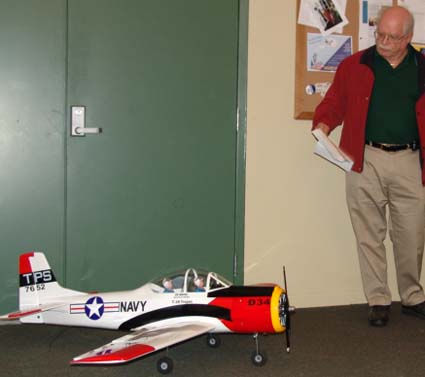
Barry Jones had two very interesting new planes, one ARF, one kit built and modified. Here's what Barry has to say about them.

The ARF T28 Trojan is sold by Black Horse models. It is designed for both electric and fuel. In fact it is possible that the Horizon Models electric ARF is the same manufacturer. The kit cost $139.00 plus $20.00 shipping from Black Horse Models.
The fuselage was complete with the pilots and canopy mounted. It has a 64 inch wing span, fixed landing gear, with flaps and ailerons hinged but not glued. The elevator/stabilizer and fin/rudder are also hinged but not glued. The cowl is painted fiberglass.
The instructions are minimal but have many pictures showing the steps to assemble.
The wing is epoxied with an aluminum tube for wing joiner and a dowel at the rear. If you look inside the fuselage they had designed in 4 plywood-mounting plates for the cowl mounting. The fuel tank had a molded in tab with a hole to allow easy tank removal. However, the tank stopper had plastic tubes, which I didnŐt like, and because of the metric diameter I could not replace it.
All the hardware was metric. Some of which I replaced like the motor mounting screws. I planned to use their metric control rods and surface actuating bolts. I normally prefer Sullivan cables for the fuselage over metal rods and would have replaced them but reviews of the model stated that weight had to be added to the rear of the plan to balance. Seeing I was using a Saito 91 engine, which is quite heavy, I left in the metal rods.
I installed the radio gear but mounted the battery pack at the rearmost part of the wing opening to help with the possible balance problem.
The wire rods for the controls were designed for a 90-degree bend at the servos with a plastic keeper. I decided to just use a zee bend. I was almost done with all the rods when one zee bend snapped off. I checked the others and sure enough all were cracked, poor material. I replaced the rods with American rods.
I cut and mounted the cowl, added the decals and checked the balance and weight.
I hang the airplane from a one-point hook and dropped a plump-bob and found the balance was perfect. Next I checked the weight and it was 7 lbs 2 oz. They stated 7 lbs 4 oz. This is the first model I ever had that was under weight. The wing loading is 24 oz. sq. ft., 11 cubic oz. per sq. ft., and a minimum stall speed of 20 mph.
I think this is a fantastically engineered model with excellent build quality. Except for some minor quality issues with material for the control rods and the tank, it is great value for the money.
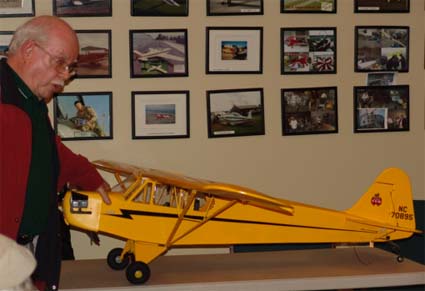
This is a 1/5th scale kit. The wingspan is 84.5 inches with a 947 in. sq. area giving approximately 17 oz. per sq ft. at 7 lbs weight. The design has an aluminum tube two- piece flat bottom wing with functional struts. It uses standard servos with two required for the wing flaps. It is designed for 45 to 65 four-stroke engines.
The kit contained very good wood, hardware, accessories and a fiberglass cowl. The wing ribs and fuselage components were laser cut. It has a two-piece wing with a 0.875 diameter aluminum tube which gets cut into two pieces and engages the fuselage by only 1 1/4 inch per side. This feature was probably designed so that the tube would not be visible through the clear roof- top.
The kit landing gear is soldered wire in grooved blocks.
Thanks Barry for the great write-ups on your planes.
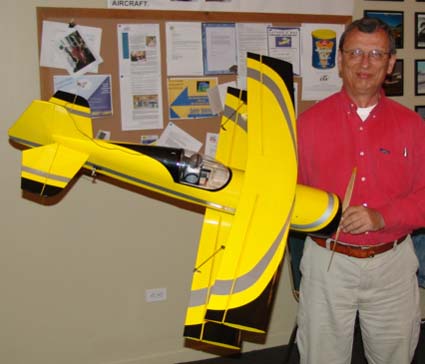
Rick Sawicki shared his Zerogravity Pitts Python. He noted how well it was designed and said it is about the same size as the old Andrews Aeromaster bipe. It has a wing area of 556.5 sq.in. and a flying weight of about 3 pounds. The motor is a Hacker outrunner. It has a HUGE hatch for easy access to the Li-Poly battery pack for easy "swaps" at the field.
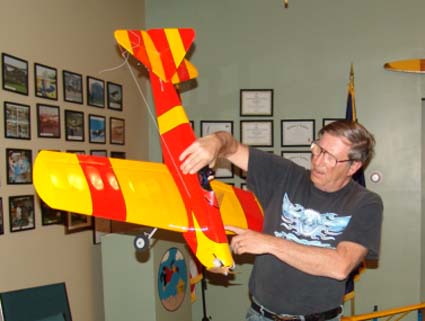
Ken Myers shared his Son of Swallow Mk II. While looking very similar to the Son of Swallow (based on the original Fred Reese Swallow) that he shared with us in March, it is about 45% all new. The cowl on this version is 1/4-inch longer than the original; to allow for the 1/4-inch longer motor mounts to move the CG slightly forward. The original was destroyed on its maiden flight in Florida. Ken believes that it was due to radio "problems" since the Mk II is an excellent flier with no bad habits.
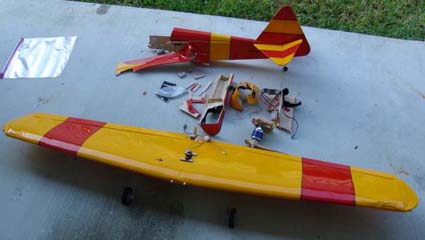
The photo shows the damage sustained on the maiden flight.
The repairs included a completely new fuselage and cowl with new "dummy" cylinders. The wing, which was "crunched" at both ends, was repaired with new sheeting and a partial wing tip replacement. The hatch was "jigsaw puzzled" back together with new pieces added. The rear stringers were removed from the original, along with the last three top formers and transplanted onto the new fuselage.
The new version was maidened on the Saturday before the meeting, and all went very well! This is one sweet flying plane.
The rebuild and repair brought the RTF weight up about 1 oz. to just shy of 42 oz. It still has about 415 sq.in. of wing area.
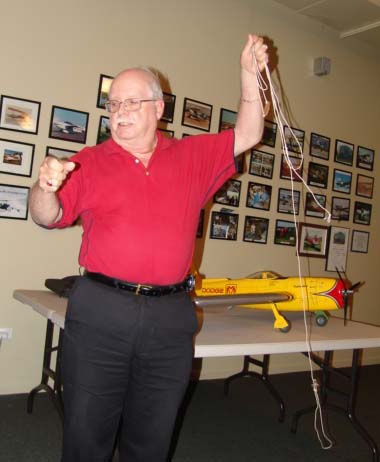
Barry Jones brought in his sling and plumb line to demonstrate how he balances his planes.
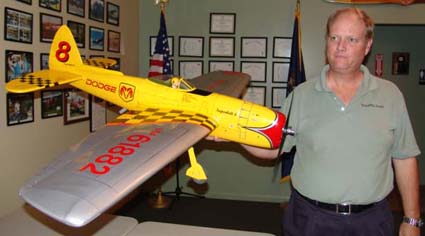
Bob McDonald shared has new semi-scale P-47E for control line stunt. It weighs 64 oz. and uses a PA-75 with tuned pipe. It is total scratch built including the prop. He lays up his own props, and described this process to the members. It is painted with some of the graphics drawn on. The smaller graphics are painted on as well. He runs the motor at about 10,500 RPM.
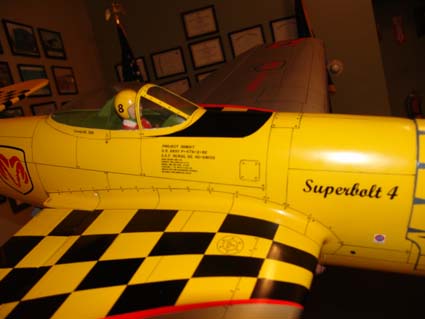
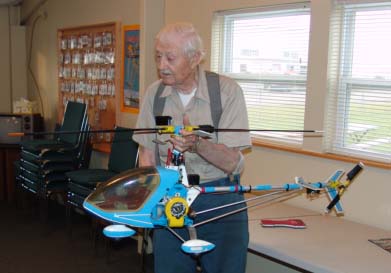
Stan Spiewak showed off his very old Schulter Mosquito helicopter, assembled from a kit. Stan painted the parts so he would know where they were placed when assembling the kit. It came with the option of using skids or wheels. The original machine had wooden blades, so he replaced with fiber blades. It uses an O.S. Max .40FSR, but he'd like to put a .50 in it. Almost all of the mechanical parts are made of metal with a belt for the tail rotor. It weighs 9 lb.
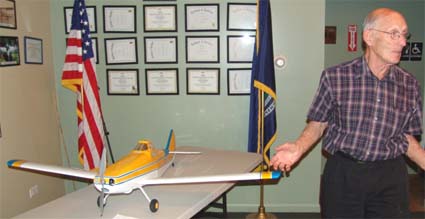
Bill Brown brought in his Piper Pawnee 15e ARF by E-flite. He was just waiting for the pilot to arrive to "button it up" and be ready for the first flight.
The specifications via Horizon's Web site are:
Wing Span: 62 in.
Overall Length: 41.5 in.
Wing Area: 550 sq.in.
Flying Weight: 4 - 4.25 lbs. (64 oz. - 68 oz.)
Motor Size: Power 15 - Power 25
Speed Control: 35 - 40 Amp brushless
Wing Loading: 16.76 oz./sq.ft - 17.8 oz./sq.ft.
Cubic Wing Loading: 8.57 oz./cu.ft. - 9.11 oz./cu.ft. (sport class flying - fairly good in the wind)
Bill is using the Power 25 in his version, so it should do very nicely.